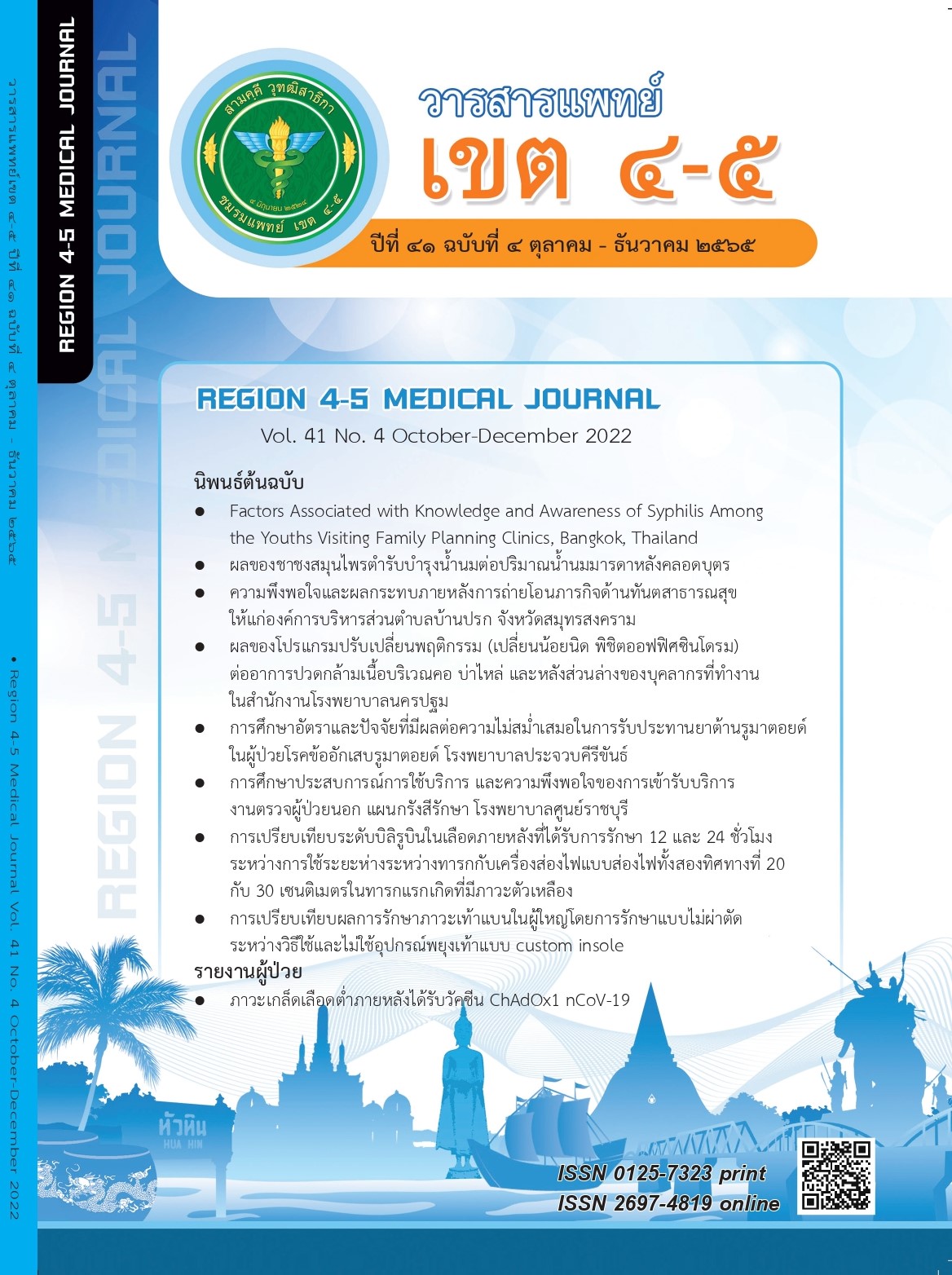การเปรียบเทียบระดับบิลิรูบินในเลือดภายหลังที่ได้รับการรักษา 12 และ 24 ชั่วโมง ระหว่างการใช้ระยะห่างระหว่างทารกกับเครื่องส่องไฟแบบส่องไฟทั้งสองทิศทางที่ 20 กับ 30 เซนติเมตรในทารกแรกเกิดที่มีภาวะตัวเหลือง
คำสำคัญ:
ระดับบิลิรูบินในเลือด, ระยะห่างระหว่างทารกกับเครื่องส่องไฟ, เครื่องส่องไฟแบบสองทิศทาง ภาวะแทรกซ้อนบทคัดย่อ
วัตถุประสงค์: เพื่อ 1) เปรียบเทียบระดับบิลิรูบินในเลือดภายหลังที่ได้รับการรักษา 12 และ 24 ชั่วโมง ระหว่างการใช้ระยะห่างระหว่างทารกกับเครื่องส่องไฟแบบส่องไฟทั้งสองทิศทางที่ 20 เซนติเมตร กับ 30 เซนติเมตร ในทารกแรกเกิดมีภาวะตัวเหลือง และ 2) เปรียบเทียบภาวะแทรกซ้อน ระหว่างการใช้ระยะห่างระหว่างทารกกับเครื่องส่องไฟแบบส่องไฟทั้งสองทิศทาง ที่ 20 เซนติเมตร กับ 30 เซนติเมตร ในทารกแรกเกิดมีภาวะตัวเหลือง
วิธีการศึกษา: การวิจัยนี้เป็นการวิจัยกึ่งทดลองแบบสองกลุ่ม ในทารกแรกเกิดมีภาวะตัวเหลืองที่รักษาตัวที่โรงพยาบาลสมเด็จพระยุพราชจอมบึง จังหวัดราชบุรี ตั้งแต่เดือนสิงหาคม พ.ศ. 2563 ถึง พฤษภาคม พ.ศ. 2565 จำนวน 52 คน แบ่งเป็นกลุ่มทดลอง 26 ราย กลุ่มควบคุม 26 ราย กลุ่มทดลองใช้ระยะห่างระหว่างทารกมีภาวะตัวเหลืองกับเครื่องส่องไฟแบบส่องไฟทั้งสองทิศทางที่ 20 เซนติเมตร ส่วนกลุ่มควบคุมใช้ระยะห่างระหว่างทารกมีภาวะตัวเหลืองกับเครื่องส่องไฟแบบส่องไฟทั้งสองทิศทางที่ 30 เซนติเมตร สถิติที่ใช้ในการวิเคราะห์ข้อมูลประกอบด้วย สถิติพรรณนา การแจงแจงความถี่ ร้อยละ ค่าเฉลี่ย ส่วนเบี่ยงเบนมาตรฐาน และสถิติอ้างอิง chi-square test และ independent t test
ผลการศึกษา: กลุ่มทดลองกับกลุ่มควบคุมมีข้อมูลทั่วไปที่คล้ายคลึงกัน ระดับบิลิรูบินในเลือดภายหลังที่ได้รับการรักษา 12 และ 24 ชั่วโมง ของกลุ่มทดลองไม่แตกต่างจากกลุ่มควบคุม ส่วนภาวะแทรกซ้อน ได้แก่ จำนวนครั้งที่ถ่ายเหลว อุณหภูมิกาย และผื่นแดง ของกลุ่มทดลองกับกลุ่มควบคุมที่จำแนกตามช่วงเวลา ไม่มีความแตกต่างกัน ยกเว้นอุณหภูมิกายที่ 20 ชั่วโมงที่พบความแตกต่างอย่างมีนัยสำคัญทางสถิติที่ระดับ .03 ส่วนน้ำหนักที่ลดลงที่ 24 ชั่วโมงของกลุ่มทดลองกับกลุ่มควบคุม ไม่มีความแตกต่างกัน
สรุป: แนวทางการดูแลทารกแรกเกิดตัวเหลืองด้วยการส่องไฟทั้งสองทิศทางควรใช้ระยะห่างระหว่างทารกกับเครื่องส่องไฟด้วยการส่องไฟทั้งสองทิศทางที่ 30 เซนติเมตร และควรติดตามภาวะแทรกซ้อนจากการส่องไฟอย่างสม่ำเสมอ เพื่อป้องกันไม่ให้เกิดอันตรายต่อทารกที่มีภาวะตัวเหลืองทั้งในระยะสั้นและระยะยาว
เอกสารอ้างอิง
Brits H, Adendorff J, Huisamen D, et al. The prevalence of neonatal jaundice and risk factors in healthy term neonates at National District Hospital in Bloemfontein. African Journal of Primary Health Care & Family Medicine. 2018;10(1):e1–e6.
Slusher T, Zamora T, Appiah D, et al. Burden of severe neonatal jaundice: a systematic review and meta-analysis. BMJ Paediatrics Open. 2017;1(1):e000105.
Khan RS, Houlihan DD, Newsome PN. Investigation of Jaundice. Medicine. 2015;43(10):573–6.
Borden A, Satrom K, Wratkowski P, et al. Variation in the Phototherapy Practices and Irradiance of Devices in a Major Metropolitan Area. Neonatology. 2018;113(3):269-274.
โสภาพรรณ เงินฉ่ำ. ภาวะตัวเหลืองในทารกแรกเกิด. ใน: สุรชัย ลิขสิทธิ์วัฒนกุล, วิฐารณ บุญสิทธิ, วาณี วิสุทธิ์เสรีวงศ์, รัตนาวลัย นิติยารมย์, บรรณาธิการ. ตำรากุมารเวชศาสตร์ศิริราช ประเด็นสำคัญในเวชปฏิบัติ เล่ม 1. ตำราศิริราช. กรุงเทพฯ:พี.เอ. ลีฟวิ่ง; 2559. น.175-92.
Faulhaber F, Procianoy R, Silveria R. Side Effects of Phototherapy on Neonates. American Journal of Perinatology. 2019;36(3):252-7.
วรรษมน ปาพรม. ผลของโปรแกรมสนับสนุนและแอปพลิเคชันให้ความรู้ต่อพฤติกรรมการดูแลของผู้ดูแลทารกแรกเกิดที่มีภาวะตัวเหลืองและได้รับการรักษาโดยการส่องไฟ. วารสารพยาบาลสงขลานครินทร์. 2561;38(3):167-78.
นงลักษณ์ วิรัชชัย. การกำหนดขนาดตัวอย่างในการทดสอบสมมุติฐานวิจัย. (เอกสารประกอบการบรรยาย เรื่อง “วิธีการที่ถูกต้องและทันสมัยในการกำหนดขนาดตัวอย่าง” ในโครงการ Research Zone จัดโดย ศูนย์การเรียนรู้ทางการวิจัย ณ อาคารศูนย์การเรียนรู้ทางการวิจัย สำนักงานคณะกรรมการวิจัยแห่งชาติ (วช.) วันที่ 26 มกราคม 2555 เวลา 9.00-12.00 น.)
Pratita W, Supriatmo S, Tjipta GD. Phototherapy for neonatal jaundice at distances of 20 cm vs 40 cm. Paediatrica Indonesiana. 2013;53(5):278–82.
Bhutani VK, Johnson LH, Sivieri EM. Predictive ability of a predischarge hour-specific serum bilirubin for subsequent significant hyperbilirubinemia in healthy term and near-term newborns. Pediatrics 1999;103:6-14.
American Academy of Pediatrics, Subcommittee on Hyperbilirubinemia. Management of hyperbilirubinemia in the newborn infant 35 or more weeks of gestation. Pediatrics. 2004;114:297-316.
เกรียงศักดิ์ จีระแพทย์. Double Phototherapy Lamp [อินเทอร์เน็ต]. กรุงเทพฯ: โรงพยาบาลศิริราช [เข้าถึงเมื่อ 18 เม.ย. 2562]. เข้าถึงได้จาก: https://dr-sak.net/project-LEDDBphoto-tha.html
Vandborg PK, Hansen BM, Greisen G, et al. Dose-response relationship of phototherapy for hyperbilirubinemia. Pediatrics 2012;130(2):e352–7.
Saikia D, Kumar S, Velpandian T, et al. Pharmacokinetics-Based Optimization of Phototherapy in Neonates Undergoing Treatment for Hyperbilirubinemia. Maedica. 2021;16(4):603–8.
Tan KL. The pattern of bilirubin response to phototherapy for neonatal hyperbilirubinemia. Pediatric research. 1982;16(8):670–4.
Schindl A, Rosado-Schlosser B, Trautinger F. Die Reziprozitätsregel in der Photobiologie. Eine Ubersicht Hautarzt [Reciprocity regulation in photobiology. An overview]. 2001;52:779-785.
Arnolda G, Chien TD, Hayen A, et al. A comparison of the effectiveness of three LED phototherapy machines, single- and double-sided, for treating neonatal jaundice in a low resource setting. PLoS One. 2018;13(10):e0205432. Available from: http://dx.doi.org/10.1371/journal.pone.0205432
Pishva N, Madani A. Effects of the different light-source distances from the skin surface in conventional phototherapy. Iran Journal of Medical Sciences. 2004;29(4):189-91.
Zardosht R, Shah Farhat A, Saeidi R, et al. Assement Efficacy and Complication of the Distance between Phototherapy Lamps and Neonate’s Body Level on Serum Bilirubin Decrease and Phototherapy Complications in Neonatal Hyperbilirubinemia. Iranian Journal of Neonatology. 2019;10(4):47-52.
Aydemir O, Soysaldı E, Kale Y, et al. Body temperature changes of newborns under fluorescent versus LED phototherapy. Indian J Pediatr. 2014;81(8):751–4.
Boonyarittipong P, Kriangburapa W, Booranavanich K. Effectiveness of double-surface intensive phototherapy versus single-surface intensive phototherapy for neonatal hyperbilirubinemia. J Med Assoc Thai. 2008;91(1):50–5.
Tourneux P, Libert J-P, Ghyselen L, et al. Échanges thermiques et thermorégulation chez le nouveau-né [Heat exchanges and thermoregulation in the neonate]. Arch Pediatr. 2009;16(7):1057–62.
Sherbiny HS, Youssef DM, Sherbini AS, et al. High-intensity light-emitting diode vs fluorescent tubes for intensive phototherapy in neonates. Paediatr Int Child Health. 2016;36(2):127-33
ดาวน์โหลด
เผยแพร่แล้ว
รูปแบบการอ้างอิง
ฉบับ
ประเภทบทความ
สัญญาอนุญาต

อนุญาตภายใต้เงื่อนไข Creative Commons Attribution-NonCommercial-NoDerivatives 4.0 International License.
ลิขสิทธิ์บทความเป็นของผู้เขียนบทความ แต่หากผลงานของท่านได้รับการพิจารณาตีพิมพ์ลงวารสารแพทย์เขต 4-5 จะคงไว้ซึ่งสิทธิ์ในการตีพิมพ์ครั้งแรกด้วยเหตุที่บทความจะปรากฎในวารสารที่เข้าถึงได้ จึงอนุญาตให้นำบทความในวารสารไปใช้ประโยชน์ได้ในเชิงวิชาการโดยจำเป็นต้องมีการอ้างอิงถึงชื่อวารสารอย่างถูกต้อง แต่ไม่อนุญาตให้นำไปใช้ในเชิงพาณิชย์




